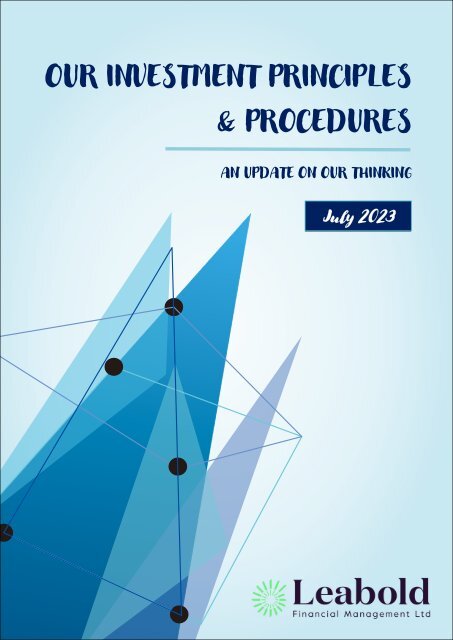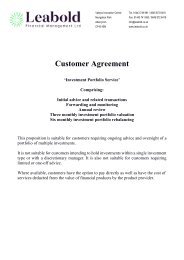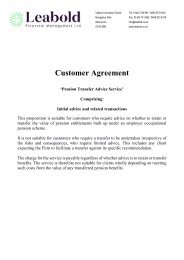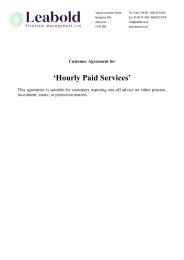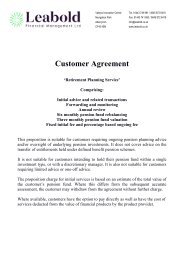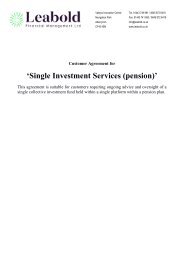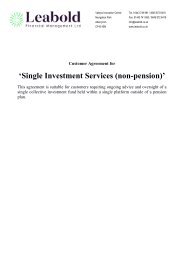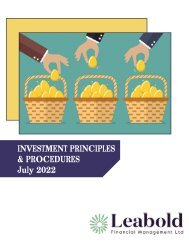Investment Principles and Procedures - An update on our thinking
You also want an ePaper? Increase the reach of your titles
YUMPU automatically turns print PDFs into web optimized ePapers that Google loves.
OUR INVESTMENT PRINCIPLES<br />
& PROCEDURES<br />
AN UPDATE ON OUR THINKING<br />
July 2023
2<br />
TABLE OF CONTENTS<br />
REASON FOR THIS DOCUMENT ..................................................................................................... 3<br />
A BRIEF HISTORY .......................................................................................................................... 3<br />
MODERN PORTFOLIO THEORY (MPT)............................................................................................ 4<br />
THE RECENT STATE OF MARKETS .................................................................................................. 5<br />
THE IMPROVEMENTS WE IDENTIFIED ........................................................................................... 8<br />
BUILDING ON VARIANCE .............................................................................................................. 8<br />
VALUE AT RISK (VaR).................................................................................................................... 9<br />
TESTING FOR NORMALITY .......................................................................................................... 10<br />
CRAMÉR-VON MISES .................................................................................................................. 11<br />
MODIFIED VALUE AT RISK (MVaR).............................................................................................. 13<br />
MVaR BACKTESTING .................................................................................................................. 15<br />
EXCEL SOLVER ............................................................................................................................ 15<br />
EXPONENTIAL SMOOTHING ........................................................................................................ 17<br />
PUTTING THIS ALL TOGETHER ..................................................................................................... 19
3<br />
REASON FOR THIS DOCUMENT<br />
We d<strong>on</strong>’t usually send out complex technical documents, but many clients have expressed an<br />
interest in what happens ‘under the b<strong>on</strong>net’. This is as unashamedly technical document, which we<br />
hope satisfies that interest <str<strong>on</strong>g>and</str<strong>on</strong>g> gives a better insight into the level of detail that we employ.<br />
We have undertaken a series of changes <str<strong>on</strong>g>and</str<strong>on</strong>g> incorporated additi<strong>on</strong>al features into <strong>our</strong> investment<br />
principles <str<strong>on</strong>g>and</str<strong>on</strong>g> procedures. This document has been produced as a means of explaining these<br />
developments <str<strong>on</strong>g>and</str<strong>on</strong>g> why we have made the decisi<strong>on</strong>s we have. For a quicker explanati<strong>on</strong>, please see<br />
the summary within secti<strong>on</strong> “Putting This All Together” <strong>on</strong> page 19.<br />
Our st<str<strong>on</strong>g>and</str<strong>on</strong>g>ard investment principles <str<strong>on</strong>g>and</str<strong>on</strong>g> procedures document, which is usually produced quarterly,<br />
will also be modified to reflect these changes. However, going forward, it will not see quarterly<br />
revisi<strong>on</strong>s. For those that utilised that document for the purposes of reviewing <strong>our</strong> <str<strong>on</strong>g>update</str<strong>on</strong>g>d fund list,<br />
this will now be provided via a separate “Fundfolio Shortlist” document, which, as a shorter<br />
document, we hope improves readability.<br />
A BRIEF HISTORY<br />
Traditi<strong>on</strong>ally, <str<strong>on</strong>g>and</str<strong>on</strong>g> for a very l<strong>on</strong>g time, we used <strong>our</strong> professi<strong>on</strong>al experience of markets <str<strong>on</strong>g>and</str<strong>on</strong>g> individual<br />
asset types to develop a range of lower risk to higher risk portfolios.<br />
However, this strategy places a significant reliance up<strong>on</strong> experience <str<strong>on</strong>g>and</str<strong>on</strong>g> knowledge, which exposed<br />
the investment decisi<strong>on</strong>s to a plethora subjective factors like intuiti<strong>on</strong>, pers<strong>on</strong>al insights, <str<strong>on</strong>g>and</str<strong>on</strong>g> past<br />
successes. For example, <strong>on</strong>e pers<strong>on</strong>’s view of what c<strong>on</strong>stitutes “low risk” may be different to<br />
another. What’s more, human decisi<strong>on</strong>-making is essentially flawed by the influence of emoti<strong>on</strong>s,<br />
biases, <str<strong>on</strong>g>and</str<strong>on</strong>g> cognitive limitati<strong>on</strong>s. For a while we explored ways in which we could remove that<br />
subjectivity, which we felt was becoming an increasing <str<strong>on</strong>g>and</str<strong>on</strong>g> material risk <str<strong>on</strong>g>and</str<strong>on</strong>g> move to an objective<br />
model.<br />
The delayed transiti<strong>on</strong> from a subjective to an objective investment model was primarily due to the<br />
challenge of accessing reliable historic data. Limited availability <str<strong>on</strong>g>and</str<strong>on</strong>g> reliability of data posed<br />
obstacles in c<strong>on</strong>structing a robust objective model. However, in the middle of 2017, technological<br />
advancements enabled us to overcome these challenges <str<strong>on</strong>g>and</str<strong>on</strong>g> make the brave decisi<strong>on</strong> to<br />
fundamentally change <strong>our</strong> approach to investment.
4<br />
MODERN PORTFOLIO THEORY (MPT)<br />
When exploring different investment c<strong>on</strong>cepts to use with <strong>our</strong> newfound s<strong>our</strong>ce of data, Modern<br />
Portfolio Theory (MPT) very quickly became the obvious choice. It is widely regarded as a<br />
fundamental c<strong>on</strong>cept in finance <str<strong>on</strong>g>and</str<strong>on</strong>g> forms a basis for how different investments can be used to<br />
together. It has stood the test of time too: it was developed by an ec<strong>on</strong>omist in the 1950s, who was<br />
later awarded a Nobel peace prize for the framework.<br />
At its core, MPT assumes that investors are rati<strong>on</strong>al <str<strong>on</strong>g>and</str<strong>on</strong>g> risk-averse, seeking to achieve the highest<br />
possible return for a given level of risk or the lowest possible risk for a given level of return. The<br />
theory revolves around the idea of diversificati<strong>on</strong>, which involves spreading investments across<br />
different asset classes to reduce overall risk.<br />
By using MPT principles, portfolios with multiple investment exposures can be c<strong>on</strong>structed in a way<br />
that, based <strong>on</strong> historic data, would offer a balance between risk <str<strong>on</strong>g>and</str<strong>on</strong>g> reward, in essence “optimising”<br />
the investment strategy at different levels of targeted return.<br />
We enacted the MPT methodology by building propriety software <strong>our</strong>selves (we called it<br />
‘pfOptimise’ (with the ‘pf’ st<str<strong>on</strong>g>and</str<strong>on</strong>g>ing for ‘Portfolio’)), <str<strong>on</strong>g>and</str<strong>on</strong>g>, since late 2017, the methodology has<br />
underpinned all of <strong>our</strong> investment decisi<strong>on</strong>s. We are very proud of it, <str<strong>on</strong>g>and</str<strong>on</strong>g> it has been a testament to<br />
what makes us difference to other financial advisers.
5<br />
THE RECENT STATE OF MARKETS<br />
The following charts show the performance for the ‘AFI Balanced’ <str<strong>on</strong>g>and</str<strong>on</strong>g> the IA Mixed <str<strong>on</strong>g>Investment</str<strong>on</strong>g> 20-<br />
60% Shares over various periods. These benchmarks are fairly comparable to <strong>our</strong> portfolios in that<br />
they c<strong>on</strong>sist of diversified portfolios that c<strong>on</strong>tain many asset types <str<strong>on</strong>g>and</str<strong>on</strong>g> geographic locati<strong>on</strong>s.
6<br />
These charts show us that diversified portfolios, similar to the <strong>on</strong>es we recommend, have seen<br />
virtually no growth <str<strong>on</strong>g>and</str<strong>on</strong>g> have been less than tranquil for the last three years. This combinati<strong>on</strong> of<br />
poor returns <str<strong>on</strong>g>and</str<strong>on</strong>g> increased risk leads to a fair <str<strong>on</strong>g>and</str<strong>on</strong>g> reas<strong>on</strong>able anxiety for any<strong>on</strong>e holding invested<br />
capital. However, while it may be difficult to remain calm during a c<strong>on</strong>siderable market instability, it<br />
is important to remember that volatility is a normal part of investing <str<strong>on</strong>g>and</str<strong>on</strong>g>, reacting emoti<strong>on</strong>ally to<br />
volatile markets may be more detrimental to l<strong>on</strong>g-term performance than the drawdown itself.<br />
We pay careful <str<strong>on</strong>g>and</str<strong>on</strong>g> frequent attenti<strong>on</strong> to investment markets. However, we felt that the volatility we<br />
were experiencing was not worthy of a knee-jerk reacti<strong>on</strong>s or fundamental changes in <strong>our</strong> model.<br />
We c<strong>on</strong>tinued to support the underlying principles behind MPT.<br />
The mathematical calculati<strong>on</strong>s for generating outputs via MPT use past performance as the input,<br />
<str<strong>on</strong>g>and</str<strong>on</strong>g> we feed the model fifteen years’ worth of weekly data across various asset classes. For the<br />
majority of this period, if we look at the broad asset classes of just equities <str<strong>on</strong>g>and</str<strong>on</strong>g> fixed interest, they<br />
have not just been popular for their positive returns, but also because of their correlati<strong>on</strong>.
7<br />
The correlati<strong>on</strong> between equities <str<strong>on</strong>g>and</str<strong>on</strong>g> fixed interest has been negative since the start of the century,<br />
resulting in a material <str<strong>on</strong>g>and</str<strong>on</strong>g> obvious diversificati<strong>on</strong> benefit. In the years when equities suffered their<br />
unusual losses, that loss was offset by the c<strong>on</strong>sequent increase in the value of fixed interest assets. A<br />
portfolio comprised of 60% in global equity <str<strong>on</strong>g>and</str<strong>on</strong>g> 40% in global fixed interest would have seen ten<br />
c<strong>on</strong>secutive positive years between 2009 <str<strong>on</strong>g>and</str<strong>on</strong>g> 2019. Ten positive years <strong>on</strong> the trot.<br />
So, why are things different now? Well, the major difference is because, unfortunately, equity-b<strong>on</strong>d<br />
correlati<strong>on</strong>s turned positive in 2020, when Covid hit. This means that, when <strong>on</strong>e fell, so did the<br />
other. It was driven by all manner of disasters: combine the inflati<strong>on</strong>ary pressures caused by covid<br />
with the growth <str<strong>on</strong>g>and</str<strong>on</strong>g> volatility shocks. Both equity <str<strong>on</strong>g>and</str<strong>on</strong>g> b<strong>on</strong>d valuati<strong>on</strong>s were depressed <str<strong>on</strong>g>and</str<strong>on</strong>g> there<br />
was no investment shelter. Even the value of cash was positively correlated, with the value falling<br />
due to inflati<strong>on</strong>, which is traditi<strong>on</strong>ally a n<strong>on</strong>-correlated asset. Everything flipped.<br />
Because of this, the “protecti<strong>on</strong>” that <strong>our</strong> model suggested was not working in reality. We did see a<br />
semblance of normality towards the end of 2021, but this was then squashed by Russia <str<strong>on</strong>g>and</str<strong>on</strong>g> the same<br />
culprits: inflati<strong>on</strong>ary pressures am<strong>on</strong>g growth <str<strong>on</strong>g>and</str<strong>on</strong>g> volatility shocks. We have seen two market events<br />
that normally occur <strong>on</strong>ce every 15-20 years, happen twice in three years.<br />
So, the questi<strong>on</strong> we believed needed answering was whether this was the new normal? We<br />
menti<strong>on</strong>ed inflati<strong>on</strong>ary <str<strong>on</strong>g>and</str<strong>on</strong>g> growth pressure above, <str<strong>on</strong>g>and</str<strong>on</strong>g> these two are key. Unexpected inflati<strong>on</strong><br />
movements tend to be rather bad news for both equities <str<strong>on</strong>g>and</str<strong>on</strong>g> b<strong>on</strong>ds, which reinforces a positive<br />
equity-b<strong>on</strong>d correlati<strong>on</strong> relati<strong>on</strong>ship going forward. On the flip side, unexpected growth movements<br />
tend to be positive for equities but negative for b<strong>on</strong>ds, which brings us back to a more familiar <str<strong>on</strong>g>and</str<strong>on</strong>g><br />
traditi<strong>on</strong>al negative equity-b<strong>on</strong>d correlati<strong>on</strong>.<br />
Early into the instability, it was easier to take the view that the situati<strong>on</strong> was atypical <str<strong>on</strong>g>and</str<strong>on</strong>g> that things<br />
would return to normal in due c<strong>our</strong>se. However, we have now seen three c<strong>on</strong>secutive years of<br />
turmoil with no obvious end in sight <str<strong>on</strong>g>and</str<strong>on</strong>g> thus, we have reached the c<strong>on</strong>clusi<strong>on</strong> that something needs<br />
to be d<strong>on</strong>e.
8<br />
THE IMPROVEMENTS WE IDENTIFIED<br />
It is worth noting that MPT has itself been subject to criticisms <str<strong>on</strong>g>and</str<strong>on</strong>g> limitati<strong>on</strong>s, such as assumpti<strong>on</strong>s<br />
of perfect markets <str<strong>on</strong>g>and</str<strong>on</strong>g> reliance <strong>on</strong> historical data. However, we remain positive that MPT is the<br />
cornerst<strong>on</strong>e of portfolio management <str<strong>on</strong>g>and</str<strong>on</strong>g> thus we are taking the view to build <strong>on</strong> what we have<br />
already, rather than fundamentally change to a different way of <strong>thinking</strong>.<br />
After much deliberati<strong>on</strong>, we established three overarching upgrades that we felt <strong>our</strong> model needed:<br />
a. A way to explain volatility <str<strong>on</strong>g>and</str<strong>on</strong>g> its implicati<strong>on</strong>s.<br />
b. A way to test the historic data set that we were passing to the model.<br />
c. A way to place a greater importance of recent data, than <strong>on</strong> older data.<br />
BUILDING ON VARIANCE<br />
Our optimisati<strong>on</strong> framework uses the historic average returns for each asset class (we refer to this as<br />
the ‘mean’) as well as the fluctuati<strong>on</strong>s of returns around the mean (we refer to this as the ‘variance’).<br />
Thus, the output in terms of the efficient portfolios can be illustrated <strong>on</strong> a chart that shows returns<br />
<strong>on</strong> <strong>on</strong>e axis, <str<strong>on</strong>g>and</str<strong>on</strong>g> variance <strong>on</strong> the other.<br />
However, when explaining variance in the c<strong>on</strong>text of mean-variance optimisati<strong>on</strong>, it can be<br />
challenging to underst<str<strong>on</strong>g>and</str<strong>on</strong>g> due to a few reas<strong>on</strong>s:<br />
<br />
<br />
The percentage that variance is expressed as seems unintuitive <str<strong>on</strong>g>and</str<strong>on</strong>g> arbitrary. For example, a<br />
mean return of 7% per annum that carries a variance of 7% per annum could mean many<br />
different things to some<strong>on</strong>e unfamiliar with statistical c<strong>on</strong>cepts, <str<strong>on</strong>g>and</str<strong>on</strong>g> it can be difficult to grasp<br />
the mathematical principles involved in calculating <str<strong>on</strong>g>and</str<strong>on</strong>g> interpreting variance. Variance is not an<br />
easily relatable c<strong>on</strong>cept in everyday life. Unlike the c<strong>on</strong>cept of average or mean, which people<br />
comm<strong>on</strong>ly encounter <str<strong>on</strong>g>and</str<strong>on</strong>g> underst<str<strong>on</strong>g>and</str<strong>on</strong>g>, variance is an abstract measure that doesn't have a direct,<br />
intuitive interpretati<strong>on</strong>.<br />
Mean-variance optimisati<strong>on</strong> places a significant emphasis <strong>on</strong> risk, specifically the volatility or<br />
variability of returns. Variance is used as a proxy for risk, assuming that higher variance indicates<br />
higher risk. However, risk can be a subjective c<strong>on</strong>cept, <str<strong>on</strong>g>and</str<strong>on</strong>g> clients may have different<br />
perspectives or risk tolerances that d<strong>on</strong>'t align with the sole c<strong>on</strong>siderati<strong>on</strong> of variance.
9<br />
VALUE AT RISK (VaR)<br />
While Value at Risk (VaR) is not an expansi<strong>on</strong> of MPT, it complements MPT by offering an expansi<strong>on</strong><br />
<strong>on</strong> variance. VaR estimates the potential loss, in percentage terms, that an investment portfolio may<br />
experience over a specific time horiz<strong>on</strong> at a given c<strong>on</strong>fidence level.<br />
MPT focuses <strong>on</strong> the relati<strong>on</strong>ship between risk <str<strong>on</strong>g>and</str<strong>on</strong>g> return, aiming to optimise the trade-off through<br />
diversificati<strong>on</strong> <str<strong>on</strong>g>and</str<strong>on</strong>g> asset allocati<strong>on</strong>. However, MPT does not provide a precise measure of the<br />
maximum potential loss a portfolio may face.<br />
We believe this is where VaR comes into play. VaR quantifies the downside risk of a portfolio by<br />
estimating the maximum loss that could occur over a specified time period at a given probability<br />
level (e.g. a 95% c<strong>on</strong>fidence level). It provides an estimate for the worst-case loss an investor can<br />
expect to experience for any given compositi<strong>on</strong> of asset types. We believe this allows for a much<br />
easier reflecti<strong>on</strong> of risk <str<strong>on</strong>g>and</str<strong>on</strong>g> what some<strong>on</strong>e may feel comfortable with, as it is easier to relate to.<br />
As an expansi<strong>on</strong> of variance, VaR similarly takes into account the distributi<strong>on</strong> of portfolio returns, the<br />
historic volatility, <str<strong>on</strong>g>and</str<strong>on</strong>g> the historic correlati<strong>on</strong> between asset types. It just presents that data in a<br />
language that we feel will provide a more comprehensive underst<str<strong>on</strong>g>and</str<strong>on</strong>g>ing of the portfolio’s risk <str<strong>on</strong>g>and</str<strong>on</strong>g><br />
allow for more informed decisi<strong>on</strong>s to be made.
10<br />
TESTING FOR NORMALITY<br />
A drawback of the VaR expansi<strong>on</strong> is the significant reliance it places <strong>on</strong> the distributi<strong>on</strong> for returns. It<br />
assumes that returns will be normally distributed. The chart below illustrates how a normal<br />
distributi<strong>on</strong> appears:<br />
When it comes to financial returns, a normal distributi<strong>on</strong> implies that the majority of returns are<br />
clustered around the mean or average return (0% in the above example), with fewer returns<br />
deviating significantly from the mean. This means that most returns are close to the average, <str<strong>on</strong>g>and</str<strong>on</strong>g> the<br />
further away we move from the mean, the fewer returns we encounter.<br />
But how sure can we be that returns follow this distributi<strong>on</strong> <str<strong>on</strong>g>and</str<strong>on</strong>g>, if they d<strong>on</strong>’t, are we comfortable<br />
relying <strong>on</strong> the VaR output when we know that its major assumpti<strong>on</strong>s are not the case?
11<br />
CRAMÉR-VON MISES<br />
The Cramér-v<strong>on</strong> Mises test is a statistical test comm<strong>on</strong>ly used to assess the goodness-of-fit for a data<br />
set to a particular theoretical distributi<strong>on</strong>. We can therefore use it to test the historic data for the<br />
normality assumpti<strong>on</strong> that VaR relies up<strong>on</strong>.<br />
The test evaluates the discrepancy between the empirical cumulative distributi<strong>on</strong> functi<strong>on</strong> (ECDF) of<br />
the sample <str<strong>on</strong>g>and</str<strong>on</strong>g> the cumulative distributi<strong>on</strong> functi<strong>on</strong> (CDF) of the theoretical distributi<strong>on</strong> being<br />
tested. It then computes a test statistic (we refer to this as the ‘t-stat’) based <strong>on</strong> the squared<br />
differences between the observed <str<strong>on</strong>g>and</str<strong>on</strong>g> expected cumulative probabilities.<br />
Using the t-stat, we can then obtain a probability value (we refer to this as the ‘p-value’), which<br />
provides a measure of this likelihood i.e. how likely does the distributi<strong>on</strong> follow the normal<br />
distributi<strong>on</strong> we are testing for, assuming that the null hypothesis is true. The null hypothesis in this<br />
case is that the empirical data <str<strong>on</strong>g>and</str<strong>on</strong>g> the theoretical ‘normal’ distributi<strong>on</strong> being tested are the same.<br />
The result of <strong>our</strong> Cramér-v<strong>on</strong> Mises test was a p-value of 0.00000589%. This indicates a str<strong>on</strong>g level<br />
of c<strong>on</strong>fidence that the null hypothesis is false, <str<strong>on</strong>g>and</str<strong>on</strong>g> thus the distributi<strong>on</strong> of returns is not normally<br />
distributed.
We have also illustrated the difference between the empirical distributi<strong>on</strong> of <strong>our</strong> historic data set<br />
<str<strong>on</strong>g>and</str<strong>on</strong>g> the theoretical ‘normal’ distributi<strong>on</strong> <strong>on</strong> the following chart:<br />
12
13<br />
MODIFIED VALUE AT RISK (MVaR)<br />
Modified Value at Risk (MVaR) addresses the limitati<strong>on</strong> of traditi<strong>on</strong>al Value at Risk (VaR), by<br />
capturing the asymmetry of returns, which we have statistical evidence of via the Cramér-v<strong>on</strong> Mises<br />
test.<br />
In c<strong>on</strong>trast to VaR, which relies up<strong>on</strong> a normal distributi<strong>on</strong>, MVaR allows for more flexibility in<br />
capturing the shape of the return distributi<strong>on</strong>, particularly when exhibit characteristics such as<br />
asymmetry (we refer to this as ‘skewness’) <str<strong>on</strong>g>and</str<strong>on</strong>g> fat tails (we refer to this as ‘kurtosis’), which deviate<br />
from the normal distributi<strong>on</strong> assumpti<strong>on</strong>.<br />
To help illustrate the effect of ‘skewness’, please see the following chart:
14<br />
To help illustrate the effect of ‘kurtosis’, please see the following chart:<br />
By incorporating skewness <str<strong>on</strong>g>and</str<strong>on</strong>g> kurtosis into the calculati<strong>on</strong>, MVaR can c<strong>on</strong>struct a more robust<br />
output, <str<strong>on</strong>g>and</str<strong>on</strong>g> in <strong>our</strong> opini<strong>on</strong>, suitably achieves <strong>our</strong> objective to better explain <str<strong>on</strong>g>and</str<strong>on</strong>g> present volatility.
15<br />
MVaR BACKTESTING<br />
Our sec<strong>on</strong>d objective was to incorporate a way of testing the historic data set that we were passing<br />
to the model. While we have already introduced an element of this under the Cramér-v<strong>on</strong> Mises<br />
test, we felt it was appropriate to also test the adequacy of <strong>our</strong> MVaR model.<br />
The Kupiec model is a widely used statistical test for backtesting the adequacy of VaR models. It<br />
assesses whether the number of VaR exceedances matches the expected number of exceedances<br />
based <strong>on</strong> a chosen c<strong>on</strong>fidence level. For example, for a 95% c<strong>on</strong>fidence level, the threshold would be<br />
the value at the 5th percentile of the distributi<strong>on</strong>.<br />
If the observed number of exceedances significantly deviates from the expected number, it suggests<br />
that the MVaR model may not be adequately capturing the risk. In such cases, the MVaR model may<br />
require adjustment or improvement.<br />
Similarly, to the Cramér-v<strong>on</strong> Mises test, the p-value plays a crucial role in the Kupiec Model. It<br />
represents the probability of observing a certain number of MVaR breaches or more, assuming that<br />
the MVaR model is accurate. In other words, it measures the c<strong>on</strong>sistency between the actual <str<strong>on</strong>g>and</str<strong>on</strong>g><br />
expected number of breaches under the assumpti<strong>on</strong> that the MVaR model is correctly calibrated.<br />
EXCEL SOLVER<br />
Excel Solver is an add-in tool in Microsoft Excel that find optimal soluti<strong>on</strong>s to complex problems. It is<br />
a powerful optimisati<strong>on</strong> tool that can be used to solve mathematical models <str<strong>on</strong>g>and</str<strong>on</strong>g> perform various<br />
types of analysis.<br />
The basic idea behind Solver is to maximise or minimise an objective functi<strong>on</strong> while satisfying certain<br />
c<strong>on</strong>straints. We can define the objective functi<strong>on</strong> to optimise, which in this case, is the associated p-<br />
value. Solver then uses various mathematical techniques, including linear programming <str<strong>on</strong>g>and</str<strong>on</strong>g><br />
n<strong>on</strong>linear optimisati<strong>on</strong> algorithms, to search for the optimal values of the variables that satisfy the<br />
c<strong>on</strong>straints <str<strong>on</strong>g>and</str<strong>on</strong>g> optimise the objective functi<strong>on</strong>.
The result of <strong>our</strong> analysis was a p-value of 99.9% at a c<strong>on</strong>fidence level of 95.8%. This indicates a<br />
str<strong>on</strong>g level of c<strong>on</strong>fidence between the observed number of exceedances with the expected number<br />
of exceedances that the MVaR model suggested at this specific c<strong>on</strong>fidence level. Please see the chart<br />
below for how the p-value changed with varying c<strong>on</strong>fidence levels, based <strong>on</strong> <strong>our</strong> historic data set:<br />
16
17<br />
EXPONENTIAL SMOOTHING<br />
Our final objective was to introduce a way of placing a greater significance <strong>on</strong> recent data, than <strong>on</strong><br />
older data.<br />
Firstly, we investigated a technique called ‘Bootstrapping’. This is a resampling technique that is<br />
comm<strong>on</strong>ly used to estimate statistical properties or quantify uncertainty in data (we refer to the<br />
uncertainty as the ‘noise’). Bootstrapping can be applied to various types of data, including timeseries<br />
data like financial returns, with its purpose to identify the "signal" in the data, then remove the<br />
‘noise’.<br />
However, the dilemma we faced was whether or not to accept that <strong>our</strong> empirical historic data set<br />
had any noise. The historic record for each asset class is indeed the historic record for each asset<br />
class <str<strong>on</strong>g>and</str<strong>on</strong>g> what happened in terms of performance <str<strong>on</strong>g>and</str<strong>on</strong>g> volatility, actually happened. Removing part<br />
of the data points within the set exposed us to the risk of incorrectly removing the wr<strong>on</strong>g data. We<br />
didn’t feel comfortable with this risk.<br />
Exp<strong>on</strong>ential smoothing is an alternative technique for regulating time-series data, including historic<br />
returns. It offers several advantages that made it an appealing approach. For example:<br />
<br />
<br />
<br />
It’s simple <str<strong>on</strong>g>and</str<strong>on</strong>g> intuitive: Exp<strong>on</strong>ential smoothing is a straightforward <str<strong>on</strong>g>and</str<strong>on</strong>g> easy-to-underst<str<strong>on</strong>g>and</str<strong>on</strong>g><br />
method. It involves assigning weights to past observati<strong>on</strong>s based <strong>on</strong> their recency, with more<br />
weight given to recent data points. This simplicity makes it accessible to both beginners <str<strong>on</strong>g>and</str<strong>on</strong>g><br />
experienced analysts, requiring minimal technical knowledge or complex mathematical<br />
calculati<strong>on</strong>s.<br />
Adaptability to Trends <str<strong>on</strong>g>and</str<strong>on</strong>g> Patterns: Exp<strong>on</strong>ential smoothing allows for the detecti<strong>on</strong> <str<strong>on</strong>g>and</str<strong>on</strong>g><br />
adjustment to underlying trends <str<strong>on</strong>g>and</str<strong>on</strong>g> patterns in the data. By assigning higher weights to recent<br />
observati<strong>on</strong>s, the method is inherently resp<strong>on</strong>sive to changes in the data, making it effective at<br />
capturing short-term variati<strong>on</strong>s <str<strong>on</strong>g>and</str<strong>on</strong>g> adjustments in historic returns. We believe this adaptability<br />
helps to provide more accurate <str<strong>on</strong>g>and</str<strong>on</strong>g> up-to-date forecasts.<br />
Computati<strong>on</strong>al Efficiency: Unlike Bootstrapping, exp<strong>on</strong>ential smoothing calculati<strong>on</strong>s are<br />
computati<strong>on</strong>ally efficient <str<strong>on</strong>g>and</str<strong>on</strong>g> can h<str<strong>on</strong>g>and</str<strong>on</strong>g>le large datasets without significant burdens. This makes it<br />
a more practical choice for extensive historical data sets <str<strong>on</strong>g>and</str<strong>on</strong>g> incorporating real-time data<br />
<str<strong>on</strong>g>update</str<strong>on</strong>g>s efficiently, as we do <strong>on</strong> a regular basis.
18<br />
<br />
Flexibility: Exp<strong>on</strong>ential smoothing offers flexibility in the choice of smoothing parameters, such as<br />
the smoothing factor or the level of weighting assigned to past observati<strong>on</strong>s. We can adjust<br />
these parameters to strike a balance between resp<strong>on</strong>siveness to recent data <str<strong>on</strong>g>and</str<strong>on</strong>g> the stability of<br />
the forecast.<br />
As menti<strong>on</strong>ed above, Exp<strong>on</strong>ential smoothing requires a smoothing parameter. For this, we decided<br />
<strong>on</strong> the half-life theory. Using half-life in exp<strong>on</strong>ential smoothing refers to the time it takes for the<br />
weight assigned to an observati<strong>on</strong> to decrease by half. A shorter half-life implies faster adaptati<strong>on</strong> to<br />
changes in the data, while a l<strong>on</strong>ger half-life results in a smoother <str<strong>on</strong>g>and</str<strong>on</strong>g> more persistent forecast. The<br />
half-life theory also carries the advantage of being created via a comm<strong>on</strong>ly used formula that you<br />
may remember from y<strong>our</strong> physics or chemistry classes:<br />
α = 1 - exp(-ln(0.5) / h)<br />
To obtain the appropriate decay rate (α) value, we specified a half-life (h) of five years. This means<br />
that the weight of each data point will decrease progressively <str<strong>on</strong>g>and</str<strong>on</strong>g> by half every five years. Please see<br />
the chart below for a visual illustrati<strong>on</strong> of how this weighting applies to <strong>our</strong> historic data:
19<br />
PUTTING THIS ALL TOGETHER<br />
We are very pleased with the upgrades we have now implemented to <strong>our</strong> investment model. These<br />
upgrades address crucial aspects of <strong>our</strong> existing model, which we hope will lead to a more<br />
comprehensive underst<str<strong>on</strong>g>and</str<strong>on</strong>g>ing of risk, y<strong>our</strong> own tolerances, <str<strong>on</strong>g>and</str<strong>on</strong>g> overall market dynamics. To<br />
summarise, the enhancements <str<strong>on</strong>g>and</str<strong>on</strong>g> their implicati<strong>on</strong>s for <strong>our</strong> investment advice are as follows:<br />
a. Explanati<strong>on</strong> of Volatility:<br />
One of the primary upgrades is the integrati<strong>on</strong> of a robust framework to explain volatility <str<strong>on</strong>g>and</str<strong>on</strong>g> its<br />
implicati<strong>on</strong>s. We underst<str<strong>on</strong>g>and</str<strong>on</strong>g> that market fluctuati<strong>on</strong>s can be unsettling, <str<strong>on</strong>g>and</str<strong>on</strong>g> we believe that<br />
transparency is paramount in fostering trust <str<strong>on</strong>g>and</str<strong>on</strong>g> c<strong>on</strong>fidence. The <str<strong>on</strong>g>update</str<strong>on</strong>g>d model incorporates<br />
sophisticated algorithms that we believe will provide clearer insights into the nature <str<strong>on</strong>g>and</str<strong>on</strong>g> impact of<br />
volatility. By better underst<str<strong>on</strong>g>and</str<strong>on</strong>g>ing volatility, this directly leads to informed decisi<strong>on</strong>s <str<strong>on</strong>g>and</str<strong>on</strong>g> a clearer<br />
picture of the potential risks <str<strong>on</strong>g>and</str<strong>on</strong>g> rewards associated with y<strong>our</strong> investments.<br />
b. Rigorous Historic Data Testing:<br />
To further enhance the reliability <str<strong>on</strong>g>and</str<strong>on</strong>g> accuracy of <strong>our</strong> investment model, we have implemented two<br />
advanced testing mechanisms for the historic data set used by <strong>our</strong> model. This testing ensures that<br />
the data employed in <strong>our</strong> investment strategies is robust, relevant, <str<strong>on</strong>g>and</str<strong>on</strong>g> reflective of market<br />
c<strong>on</strong>diti<strong>on</strong>s. By subjecting the data to comprehensive analysis, we can identify any potential biases or<br />
anomalies, allowing us to fine-tune <strong>our</strong> strategies <str<strong>on</strong>g>and</str<strong>on</strong>g> provide you with what we hope to be more<br />
reliable investment recommendati<strong>on</strong>s.<br />
c. Emphasising Recent Data:<br />
Recognising the evolving nature of financial markets, we have placed a greater emphasis <strong>on</strong> recent<br />
data in <strong>our</strong> upgraded model. While historical data remains an essential comp<strong>on</strong>ent of <strong>our</strong> analysis,<br />
the new approach recognises that recent market trends <str<strong>on</strong>g>and</str<strong>on</strong>g> developments can have a more<br />
immediate impact <strong>on</strong> investment outcomes. By prioritising recent data, we aim to capture timely<br />
insights <str<strong>on</strong>g>and</str<strong>on</strong>g> adapt to changing market dynamics more effectively.<br />
Our aim is to provide you with a more transparent investment experience, helping you achieve y<strong>our</strong><br />
financial goals with greater precisi<strong>on</strong> <str<strong>on</strong>g>and</str<strong>on</strong>g> c<strong>on</strong>fidence.<br />
Should you have any questi<strong>on</strong>s or require further clarificati<strong>on</strong> regarding these upgrades, we are<br />
ready to assist. We appreciate y<strong>our</strong> trust <str<strong>on</strong>g>and</str<strong>on</strong>g> c<strong>on</strong>tinued partnership <str<strong>on</strong>g>and</str<strong>on</strong>g> look forward to the<br />
prosperous j<strong>our</strong>ney ahead.


